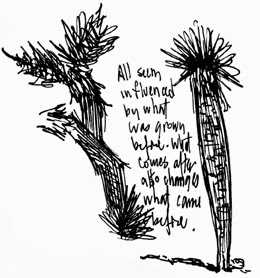Now that I think of it, didn't Theodor Seuss Geisel live in La Jolla, just a couple of hours from the Mojave Desert?
(Now that I think more on it, didn't editorial cartoonist Scott Stantis get born in San Diego and educated in Long Beach, not far from the Mojave Desert? His [annoyingly bad] comic strip "Prickly City" used to feature a tumbledown background of stacked rounded boulders, so much like the Jumbo Rocks of the National Park.)
We camped at the dreams' source last week.
In short time, the Joshua trees became normal. The writhing, spiky non-tree trees inspired Mormon pioneers, or so is said, to name them after the leader of the Israelites, raising arms in supplication to God.
They grow in the Mojave Desert far apart from one another, as if planted there by some Johnny Joshua Seed, casting seedlings oh so carefully.
Relaxing beside them for a couple of days gave us a chance to examine them closely. Their fronds are bayonets, merciless against the complacent camper. Despite that, Gambel's quail and cactus wrens darted about their prickly defenses without a flinch.
The spikes fold down as they age, as new spikes from the ends of the tormented branches. Aging spikes become a barky beard enshrouding each branch.
The trunk is tree-like, rough like an elm or ash.
Having come to peace with the Joshua tree, I could obsess about other strangeness, notably the desert trumpet plant.
It's an anomaly. It shouldn't survive desert winds, being fat where it should be thin and vice verse. Yet there it stands by the side of the road, reaching to the spring sun, gray green in spring (we couldn't tell if spring is early, late or on time here). By fall the trumpet plant branches like neurons in the brain, and turns cream and red. Last week the top of each stem ended in little curlycues of future weird stems, future floo floopers, straight out of Whoville.
Happy Earth Day.




Happy earth day to you too!
ReplyDeletepsI love Joshua tree park... X
:) nic
Delete